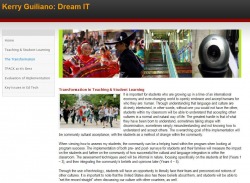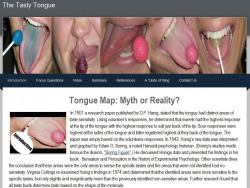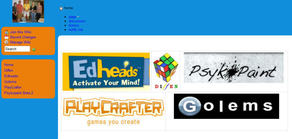Summer Hybrid Coursework - 2010
The courses included in the MAET Summer Hybrid Cohort include CEP 800: Psychology of Learning in School and Other Settings, CEP 815: Technology and Leadership, and CEP 822: Approaches to Educational Research.
The instructors for the hybrid coursework were Dr. Punya Mishra, Sara Beauchamp-Hicks, and Jessica Knott. The course was a hybrid taken on the Michigan State University campus for two weeks with a four week online component. We then met again at the end of the course in East Lansing.
The instructors for the hybrid coursework were Dr. Punya Mishra, Sara Beauchamp-Hicks, and Jessica Knott. The course was a hybrid taken on the Michigan State University campus for two weeks with a four week online component. We then met again at the end of the course in East Lansing.
Final Course Reflection
Dream IT: Technological Innovation Grant Proposal

The focus of the Dream IT assignment is to develop a grant proposal that presents how I will intelligently integrate new technologies to help develop student understanding within the Spanish classroom in a transformational way. The ideas of TPACK are integrated in all aspects of the assignment.
My personal Dream IT proposal was developed to integrate language and culture within my classroom and, on a greater scale, within my community. As a background, students within the school district struggle to imagine these cultural experiences because of the “Americanized view” that is prevalent there. It is important, as a World Language educator and US Citizen, that the students understand and accept other cultures as different, not weird or bad, but simply different. Through the use of video-conferencing software, which is the technological integration I propose, the students will gain acceptance, which will also aid in language learning and cultural awareness..
My personal Dream IT proposal was developed to integrate language and culture within my classroom and, on a greater scale, within my community. As a background, students within the school district struggle to imagine these cultural experiences because of the “Americanized view” that is prevalent there. It is important, as a World Language educator and US Citizen, that the students understand and accept other cultures as different, not weird or bad, but simply different. Through the use of video-conferencing software, which is the technological integration I propose, the students will gain acceptance, which will also aid in language learning and cultural awareness..
Understanding Understanding: The Tasty Tongue

Cognitivism: A Look at Concept Mapping in the Classroom
We utilized a Screencast to showcase 1) How to use the software Inspiration, and 2) to discuss a concept with the software, Memory Retention skills within the Cognitivist Approach to learning. We constructed a map using Inspiration which included core ideas of learning theories from the cognitive perspective as well as applications of the ideas for our own teaching.
By using a Screencast, we were able to synthesize our learning in the way we wanted that we prepared in advance and then showed the Screencast video to our peers with our presentation.
Students, in the same regard, can prepare their presentation and showcase it with a Screencast. They are able to utilize the Screencast for advanced preparation and can re-do the Screencast to their liking for their final presentation. It's a great idea for students who are shy in front of their class, but also a great creativity outlet for students who want to take their presentation to the next level. It's a wonderful way to integrate technology in a meaningful way, and it's free, as well.
By using a Screencast, we were able to synthesize our learning in the way we wanted that we prepared in advance and then showed the Screencast video to our peers with our presentation.
Students, in the same regard, can prepare their presentation and showcase it with a Screencast. They are able to utilize the Screencast for advanced preparation and can re-do the Screencast to their liking for their final presentation. It's a great idea for students who are shy in front of their class, but also a great creativity outlet for students who want to take their presentation to the next level. It's a wonderful way to integrate technology in a meaningful way, and it's free, as well.
Disproving Physics Video
Through the use of video, we work to disprove a theory presented in class that balls of different sizes and weights land at different times when pushed from a table at the same time. We also determine where a ball lands when dropped at a stand-still, walking, and running. Watch the video to find out!
Using Technology in Professional Development and Leadership

We were assigned to create a Wikispace to focus on an area of Professional Development for other educators. Using the Wikispace, we could all contribute to the space using our own login and password. We could also track the changes being made by each colleague and, if necessary, could revert pages back to previous pages.
Students can use a Wikispace to create their own content. It allows a lot of differentiation between the pages and gives way to their own creativity. I can also monitor what each student is working on, revert pages in case someone deletes something, and have students take ownership in their work online.
When we created the Wikispace Using Technology to Engage in Professional Development and Leadership, we included several different ideas that include an annotated list of key online resources for the topic. We included a surplus of quality resources that will be useful to someone seeking to learning more about the topic. The best part? Other educators can add to the space with additional resources.
Creativity using WikiSpaces

We were assigned to create a Wikispace to focus on an area of Creativity for other educators. Using the Wikispace, we could all contribute to the space using our own login and password. We could also track the changes being made by each colleague and, if necessary, could revert pages back to previous pages.
The five technologies we assessed were: EdHeads, Diffen,PsykoPaint, PlayCrafter and Golems. Using our Creativity Wikispace, we showcased these five technologies.
